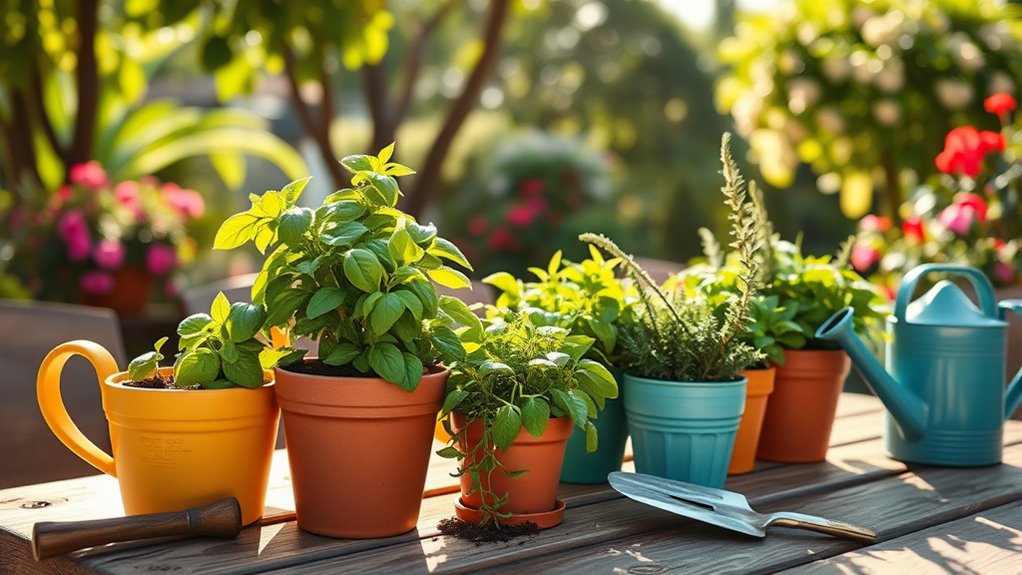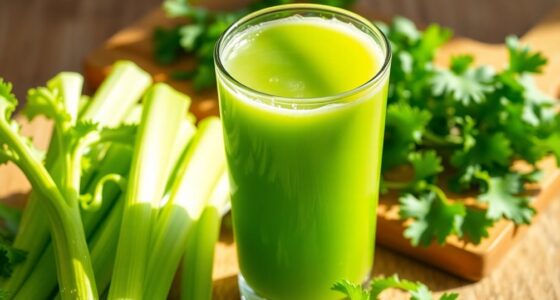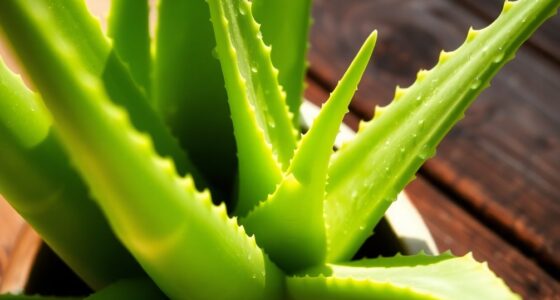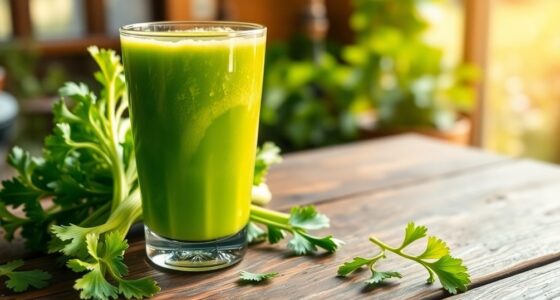To start a container herb garden in July, choose heat-loving herbs like basil, rosemary, and lemon thyme, and select containers with good drainage. Use quality potting soil and guarantee each herb has enough space to grow. Place your containers in full sun, water regularly, and monitor for pests. Proper pruning and harvesting keep your herbs healthy and productive. Keep exploring for more tips on creating a thriving, lush summer herb garden.
Key Takeaways
- Select heat-tolerant herbs like basil, rosemary, and thyme suited for full sun and summer growth.
- Use well-draining containers with quality potting mix enriched with compost for healthy roots.
- Ensure at least 6 hours of direct sunlight daily and establish a consistent watering schedule early morning or late afternoon.
- Space herbs appropriately based on their growth habits to promote airflow and prevent overcrowding.
- Regularly prune and harvest herbs to encourage bushier growth, monitor for pests, and maintain overall plant health.
Choosing the Right Herbs for Your Summer Garden
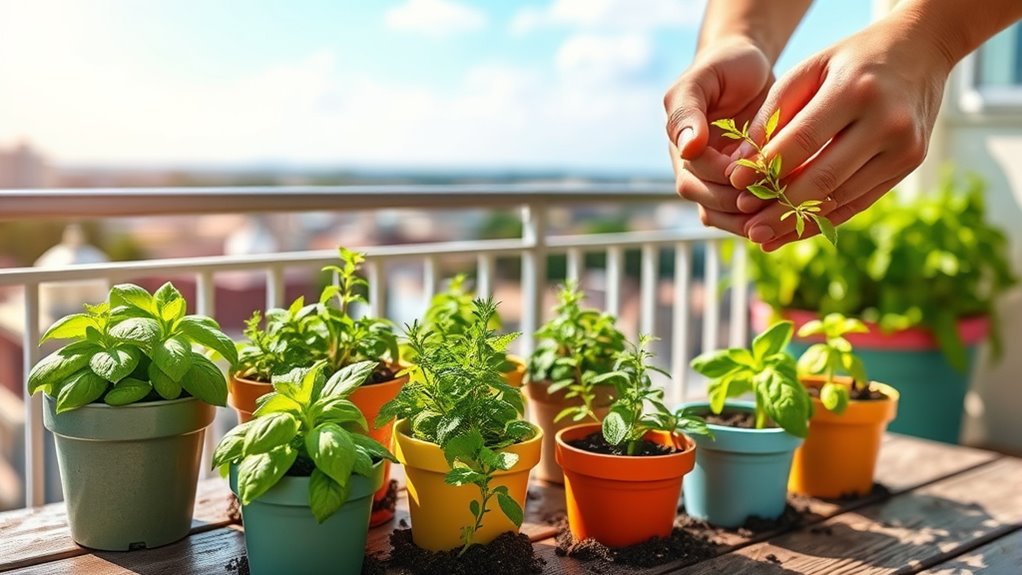
When selecting herbs for your summer container garden, it’s essential to choose varieties that thrive in warm weather and full sun. Consider herb flavor combinations that complement each other, like basil with tomatoes or rosemary with lemon thyme. This helps you create flavorful dishes and maximize your garden’s potential. Additionally, think about your gardening approach—organic or conventional. Organic gardening emphasizes natural methods, which can enhance herb flavor and aroma, while conventional practices may offer faster growth and higher yields. Both methods can produce healthy, tasty herbs if you select the right varieties and care for them properly. Focus on herbs that are well-suited to July’s heat, and plan your plantings accordingly for a vibrant, fragrant container garden. Incorporating proper watering techniques into your routine can also promote healthier plant growth and vitality, and choosing the right watering schedule can prevent issues like root rot or drought stress. To further ensure your herbs flourish, consider regular maintenance and cleaning of your containers and tools to keep your garden healthy.
Selecting Suitable Containers and Soil

Choosing the right containers and soil is essential for your herb garden’s success in July. Select containers with drainage holes to prevent waterlogging, and consider materials like terracotta, plastic, or ceramic, which each have benefits for moisture retention and breathability. Larger containers give herbs room to grow, so pick sizes appropriate for each plant’s mature size. For soil, start with a high-quality potting mix designed for container gardening. Enhance it with soil amendments like compost or organic matter to boost nutrients and improve drainage. Avoid garden soil, which can compact and hinder root growth. Proper containers and enriched soil create a healthy environment, ensuring your herbs thrive during the heat of summer. Additionally, using self watering plant pots can help maintain consistent moisture levels, reducing the need for frequent watering and supporting healthy herb growth.
Planting and Spacing Your Herbs Properly

When planting your herbs, choose containers that give each plant enough room to grow without overcrowding. Pay attention to their growth habits so you can space them properly, ensuring they have good airflow and access to nutrients. Proper sizing and spacing help your herbs stay healthy and thrive throughout the season.
Choose Appropriate Container Sizes
Selecting the right container sizes is essential for healthy herb growth, as overcrowded roots can stunt development and reduce yields. Choose pots with drainage holes to prevent waterlogging, which can lead to pests and disease. Smaller containers are suitable for herbs like basil and parsley, while larger ones are better for rosemary or mint. Proper container size supports your herb’s fertilizer needs, ensuring nutrients are not overly concentrated or too sparse. When selecting containers, consider pest control strategies by avoiding overcrowding, which can foster pest infestations. Well-sized containers promote healthy roots and better air circulation, minimizing pest problems and reducing the need for chemical treatments. Additionally, using drainage material can further improve soil drainage and prevent root rot, supporting overall plant health. Furthermore, appropriate container size can influence the overall success of your herb garden by encouraging vigorous growth and resilience. To further promote healthy growth, ensure that containers are made from breathable materials that allow for proper soil aeration. Good soil quality is also vital for providing essential nutrients and maintaining proper moisture levels, which are crucial for herb vitality. Additionally, choosing containers with the right size can help prevent root crowding and promote stronger plant development. Remember, choosing appropriately sized containers helps your herbs thrive with minimal fuss.
Maintain Adequate Spacing
Proper spacing is essential to give your herbs room to grow and prevent overcrowding, which can lead to competition for nutrients and increased risk of disease. When planting, ensure each herb has enough space to develop fully, promoting healthy growth. Additionally, maintaining proper spacing can improve overall air circulation, reducing the likelihood of fungal infections and other issues. Proper spacing also facilitates watering efficiency, ensuring each plant receives adequate moisture without excess runoff. Remember these tips: 1. Space herbs according to their mature size to avoid overcrowding. 2. Group compatible herbs to improve pest resistance and encourage healthy growth. 3. Use proper spacing to facilitate air circulation, reducing disease risk. Also, appropriate spacing can enhance companion planting, allowing beneficial herbs to support pest control naturally. Maintaining proper distance helps your herbs thrive, keeps pests at bay, and supports natural pest control strategies. Well-spaced herbs can also benefit from optimized light exposure, which is crucial for photosynthesis and growth. Proper spacing ultimately leads to a healthier, more productive container herb garden.
Consider Growth Habits
Understanding the growth habits of your herbs helps you tailor their planting and spacing to support healthy development. Different herbs have unique growth patterns that influence how much space they need and how they should be arranged. For example, basil tends to spread quickly and may need more room to prevent overcrowding, while thyme remains compact and requires less space. Considering herb longevity is also important; some herbs, like rosemary, grow slowly but live for years, so giving them adequate space promotes long-term health. Additionally, water parks often feature water slides, lazy rivers, and wave pools that cater to various age groups, highlighting the importance of space and layout—similar principles apply when planning your herb garden to ensure each plant has enough room for airflow and growth. Properly considering growth habits, such as plant size, leads to a vibrant, productive container herb garden that thrives throughout the season. Paying attention to each herb’s specific growth pattern can help you optimize your garden’s layout and improve overall success. Being aware of plant spacing requirements ensures your herbs have enough room to flourish without competing for resources.
Providing Adequate Sunlight and Watering

To keep your herbs thriving, make certain they get the right amount of sunlight each day, usually at least 6 hours. Water your containers consistently, avoiding both dryness and overwatering, especially during hot July days. Following a regular watering schedule helps your herbs stay healthy and productive. Incorporating proper lighting conditions ensures optimal growth and flavor development. Additionally, understanding sound design principles can help you create an environment that supports healthy plant growth through targeted auditory cues. Utilizing automation in watering can further optimize hydration, reducing the need for constant manual monitoring and ensuring your herbs receive consistent care. Being aware of AI in agriculture advances can also provide innovative tools for monitoring and maintaining your garden efficiently. Recognizing plant health monitoring technologies can help you detect issues early and respond promptly.
Sunlight Requirements Clarified
Ensuring your container herbs receive enough sunlight and water is essential for healthy growth in July. Different herbs have varying sunlight needs, especially when choosing between perennial vs annual varieties. Perennials often thrive with consistent sunlight, while annuals may need more direct exposure to flourish. Whether you grow indoors or outdoors influences sunlight requirements; outdoor herbs generally need full sun, while indoor herbs may require supplemental grow lights. To optimize growth, keep these points in mind:
- Aim for at least 6 hours of direct sunlight daily for most herbs.
- Adjust sunlight based on herb type—perennials might tolerate partial shade better than annuals.
- Rotate containers regularly to ensure even sunlight exposure and prevent legginess.
Watering Schedule Tips
Consistent watering is essential for healthy container herbs, especially during hot July days. Water your plants early in the morning or late in the afternoon to prevent evaporation and guarantee they stay hydrated. Proper watering supports companion planting strategies, helping herbs grow strong and resist pests naturally. When herbs are well-watered, they’re less stressed and less likely to attract pests, aiding in pest control. Check soil moisture daily; herbs like basil and cilantro prefer moist but well-drained soil. Avoid overwatering, which can lead to root rot. Mulching your containers can also help retain moisture. By maintaining a reliable watering schedule, you promote healthy growth, improve pest resistance, and make your container herb garden thrive throughout July.
Managing Growth and Harvesting Techniques
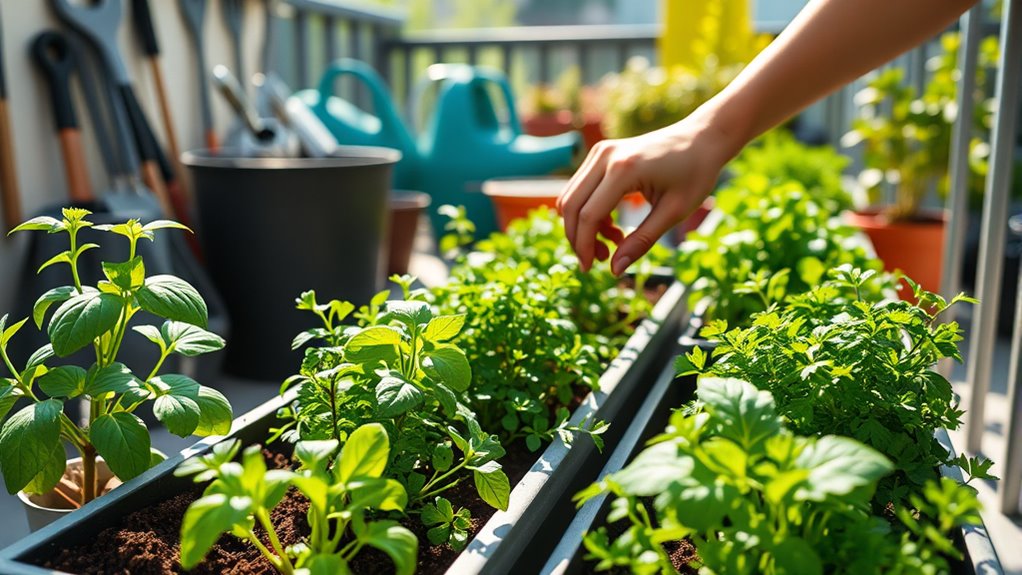
Managing growth and harvesting techniques are essential for maintaining a healthy and productive container herb garden in July. To keep your herbs thriving, focus on regular seasonal pruning to promote bushier growth and prevent legginess. Proper pest control is crucial; inspect plants frequently and remove pests early to avoid damage. When harvesting, use sharp scissors to clip herbs just above a leaf set, encouraging new growth.
Here are three key tips:
- Prune herbs regularly to maintain shape and vigor.
- Monitor for pests and treat promptly.
- Harvest in the morning for the best flavor and fragrance.
Tips for Maintaining a Thriving Container Herb Garden
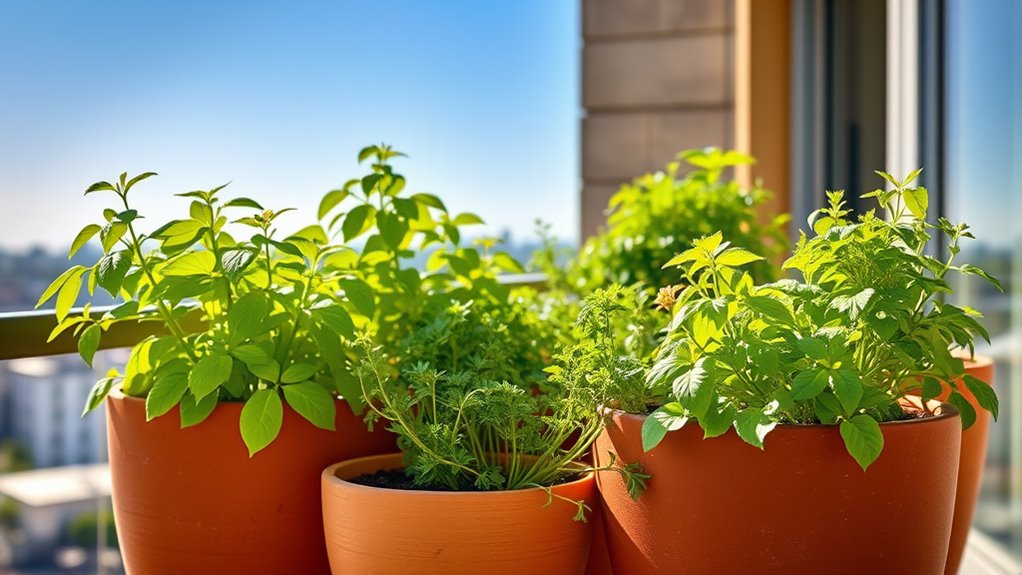
To keep your container herb garden thriving in July, you need to pay close attention to ongoing care and maintenance. Proper herb pest management is key—regularly inspect your plants for pests like aphids or spider mites, and address issues promptly with natural solutions or insecticidal soap. Also, consider container placement carefully; position your herbs where they receive adequate sunlight, usually 6-8 hours daily, and ensure good air circulation to prevent diseases. Rotate containers if some areas become shaded or overly damp. Water consistently, keeping soil moist but not waterlogged. Remove any yellowing or damaged leaves to promote healthy growth. With attentive pest management and strategic container placement, your herbs will flourish throughout July.
Frequently Asked Questions
How Often Should I Fertilize My Summer Herb Containers?
You should fertilize your summer herb containers regularly to maintain healthy soil nutrients. Typically, a bi-weekly fertilization schedule works well, using a balanced liquid fertilizer. This guarantees your herbs get the essential nutrients they need for robust growth. Remember, over-fertilizing can harm your plants, so stick to the recommended amounts. Keep an eye on your herbs, and adjust if you notice signs of nutrient deficiencies or excess.
Can I Grow Herbs Indoors During July?
Did you know that over 70% of home gardeners grow herbs indoors? You definitely can grow herbs indoors during July. Just make certain you provide ample indoor lighting—like south-facing windows or grow lights—to mimic summer sun. It’s perfect for herb seed starting, especially if outdoor conditions aren’t ideal. With proper care, you’ll enjoy fresh herbs year-round, even in the heat of July.
What Pests Commonly Affect Container Herbs in Summer?
In summer, pests like aphids, whiteflies, and spider mites often target your container herbs. To keep them healthy, you should focus on pest identification early, so you can address issues promptly. Use organic pest control methods like neem oil or insecticidal soap, which are safe for herbs and eco-friendly. Regularly inspect your plants and remove pests manually if needed, ensuring your herbs thrive throughout the season.
How Do I Prevent Herbs From Bolting in Hot Weather?
Did you know that herbs tend to bolt faster in hot weather, often within just a few weeks? To prevent this, focus on shade gardening and provide your herbs with some relief from direct sun. Keep watering frequency consistent—don’t let the soil dry out—since stress encourages bolting. Regularly harvesting your herbs also helps, as it signals them to keep producing fresh, flavorful leaves instead of flowering early.
Are There Herbs That Thrive Better in Shade During July?
In summer shade gardening, you can choose shade tolerant herbs that thrive better in less sunlight during July. Herbs like cilantro, mint, chives, parsley, and lemon balm handle shade well and stay productive. These herbs prefer cooler, shaded conditions, making them ideal for hot weather. By selecting the right shade-tolerant herbs, you guarantee a successful, lush garden even during peak summer heat.
Conclusion
Starting your container herb garden in July is a rewarding way to enjoy fresh flavors all summer. With the right herbs, containers, and care, you can cultivate a thriving garden even in the heat. Some say herbs grow best when they’re stressed, but science shows consistent watering and proper sunlight truly boost growth. Embrace the journey, and soon you’ll savor fragrant, homegrown herbs that make every meal special. Happy gardening!
Susannah expertise lies in researching and compiling evidence-based content on juicing, nutrition, and overall health. She is committed to ensuring that The Juicery World offers accurate, up-to-date, and trustworthy information to empower readers to take control of their health. Susannah’s goal is to inspire individuals to embrace juicing as a way to nourish their bodies and live their best lives.

